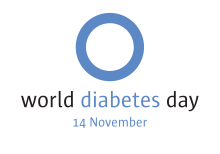World Diabetes Day 2024 Rajesh Jain1, Veeraswamy Seshiah2 Sadhana Tiwari3, Shweta Verma4 Corresponding Author: Dr Rajesh Jain, MD chair, Diabetes Asia, Jain Hospital & Research Centre, Kanpur-208007, India. Email: [email protected] World Diabetes Day (WDD) is the main global awareness campaign dedicated to Diabetes mellitus, held annually on November 14 [1] World Diabetes Day, initiated by the International Diabetes Federation (IDF) and WHO, is a testament to our ongoing commitment to the fight against Diabetes. Each World Diabetes Day focuses on a diabetes-related theme. Type 2 diabetes, a noncommunicable disease rapidly increasing in numbers worldwide, can be prevented. Type 1 diabetes, unfortunately, is not preventable but can be managed with insulin injections[2]. The day also includes discussions on human rights, NCDs and lifestyle, obesity, Diabetes in the LMIC and the vulnerable, and Diabetes in children and adolescents. The campaigns, which run year-round, ensure that we are constantly engaged in the fight against Diabetes, not just on November 14 but every day of the year. The day marks the birthday of Frederick Banting, who, along with Charles Best, first conceived the idea that led to insulin’s discovery in 1922[3] History Figure 1: World Diabetes Day on November 14, 2024, at Vimla Group, Kanpur Himeji Castle lit up for WDD on World Diabetes Day on November 14, 2008 World Diabetes Day, a global initiative started in 1991 by the International Diabetes Federation and the World Health Organization (WHO), responded to the alarming rise in diabetes cases worldwide. This initiative has since united people from all corners of the globe, fostering a sense of global unity in the fight against Diabetes. The General Assembly’s resolution, A/61/L.39/Rev.1 / Add.1, adopted at the UN on December 20, 2006, was a significant step in establishing World Diabetes Day. This resolution, numbered 61/225, officially established World Diabetes Day, further highlighting the global concern about the rapid increase in diabetes cases. It’s important to be aware of these international initiatives and resolutions to understand the severity of the issue. By 2016, over 230 IDF Member Associations in more than 160 countries and territories actively participated in World Diabetes Day. This global movement is a testament to the widespread support for the cause, with diverse participants, from international organizations and companies to healthcare professionals, politicians, celebrities, and, most importantly, people with Diabetes and their loved ones. Around the world, 536.66 million adults were living with Diabetes in 2021, Which will be 592 million by 2035, which was 108 million in 1980. The global prevalence of Diabetes has twice risen from 4.7% to 8.5% in the adult population, which indicates increased risk factors: overweight, obesity, and other risk factors for NCDs. Over the past two decades, diabetes prevalence growth has been twice that of low- and middle-income countries compared to high-income nations. Diabetes major complications of blindness, kidney failure, heart attack, stroke, and lower limb amputation are well recognized. A healthy diet low in carbohydrates, physical activity, and avoiding tobacco consumption can help prevent or delay type 2 diabetes. Moreover, Diabetes can be treated, and its complications may be delayed or delayed with medication, regular screening, and treatment for complications. The General Assembly adopted resolution 61-225 in 2007, fixing November 14 as WDD World Diabetes Day. The statement recognized the “organized ” need to follow multilateral efforts to prevent, promote, and protect human health and provide access to treatment and healthcare education.” The resolution also motivates Nations and states to develop national health policies for the prevention/control, treatment, and health management of Diabetes in line with the sustainable development SDGs of their healthcare systems. Diabetes and well-being Diabetes and well-being are the theme for World Diabetes Day 2024-26. With appropriate access to diabetes care and support for their well-being, everyone with Diabetes can live well. Millions of people with Diabetes face daily challenges managing their condition at home, work, and school. They must be resilient, organized, and responsible, which impacts their physical and mental well-being. Diabetes care often focuses only on blood sugar, leaving many overwhelmed. This World Diabetes Day, November, let’s put well-being at the heart of diabetes care and start the change for a better diabetes life. Background Diabetes is an NCD/chronic disease that occurs when insulin resistance develops, the pancreas does not produce enough insulin, or the body does not effectively use it, which leads to an increased glucose concentration in the blood (hyperglycemia). Type 1 diabetes/ previously known as IDDM insulin-dependent or childhood-onset diabetes, is due to a lack of insulin secretion. Type 2 diabetes (formerly called NIDDM, non-insulin-dependent, or adult-onset diabetes) is caused by the body’s dysfunctional utilization of insulin. It results from increased body weight and physical inactivity. Gestational Diabetes is hyperglycemia that is first recognized during pregnancy. Global Diabetes Walk from World Diabetes Foundation As per IDF Atlas 2021, With over 537 million adults living with Diabetes worldwide, a number predicted to rise to 783 million bit’s45, it’s more important than ever to spread awareness about this disease. Diabetes affects people from all walks of life. However, it is particularly prevalent in low- and middle-income countries (LMICs), where more than 75% of people living with Diabetes reside and where access to healthcare and health education may be limited. The Global Diabetes Walk is organized by the World Diabetes Foundation, a leading funder of diabetes prevention and care projects in LMICs, which aligns with its primary prevention intervention area. The Walk contributes to the annual International Diabetes Federation campaign for World Diabetes Day on November 14. In 2024, we celebrate 20 years of raising awareness together. Since 2004, more than 6 million people have joined the Walk, making it a powerful force for change in the fight against Diabetes. We aim to inspire people worldwide to act and get walking for diabetes awareness. We believe that everyone has a role to play. Whether you are an individual, a family, a community, or an organization, you can make a difference by getting involved in the Global Diabetes Walk. Figure 2 The theme for World Diabetes Day 2024-2026 is Diabetes and well-being. As a result, the Walk campaign this year will highlight the benefits of exercise for the physical, societal, and mental well-being of people



